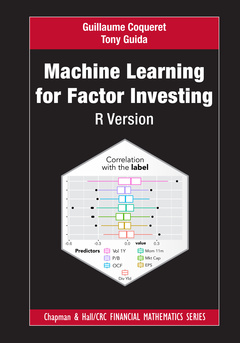Description
Machine Learning for Factor Investing: R Version
R Version
Chapman and Hall/CRC Financial Mathematics Series
Authors: Coqueret Guillaume, Guida Tony
Language: English
Subjects for Machine Learning for Factor Investing: R Version:
Keywords
Style Investing; Random Forest; financial backtesting; Sharpe Ratio; quantitative finance; Agnostic; asset management; MSE; algorithmic trading; Ml Algorithm; portfolio allocation; Machine Learning; Training Sample; factor investing machine learning; Minimum Variance Portfolios; R code samples; Hit Ratio; Bayesian additive trees; Accounting Ratios; autoencoders; Lasso; Holds; Original Training Sample; Ridge Regression; Loss Function; Support Vector Machines; Information Ratios; Penalization Intensity; Portfolio Weights; Conditional Expectations; Federal Reserve; Violate; Factor Investing; Shapley Values
214.69 €
In Print (Delivery period: 14 days).
Add to cartPublication date: 09-2020
· 17.8x25.4 cm · Hardback
Publication date: 09-2020
· 17.8x25.4 cm · Paperback
Description
/li>Contents
/li>Readership
/li>Biography
/li>
Machine learning (ML) is progressively reshaping the fields of quantitative finance and algorithmic trading. ML tools are increasingly adopted by hedge funds and asset managers, notably for alpha signal generation and stocks selection. The technicality of the subject can make it hard for non-specialists to join the bandwagon, as the jargon and coding requirements may seem out of reach. Machine Learning for Factor Investing: R Version bridges this gap. It provides a comprehensive tour of modern ML-based investment strategies that rely on firm characteristics.
The book covers a wide array of subjects which range from economic rationales to rigorous portfolio back-testing and encompass both data processing and model interpretability. Common supervised learning algorithms such as tree models and neural networks are explained in the context of style investing and the reader can also dig into more complex techniques like autoencoder asset returns, Bayesian additive trees, and causal models.
All topics are illustrated with self-contained R code samples and snippets that are applied to a large public dataset that contains over 90 predictors. The material, along with the content of the book, is available online so that readers can reproduce and enhance the examples at their convenience. If you have even a basic knowledge of quantitative finance, this combination of theoretical concepts and practical illustrations will help you learn quickly and deepen your financial and technical expertise.
1. Preface 2. Notations and data 3. Introduction 4. Factor investing and asset pricing anomalies 5. Data preprocessing 6. Penalized regressions and sparse hedging for minimum variance portfolios 8. Neural networks 7. Tree-based methods 9. Support vector machines 10. Bayesian methods 11. Validating and tuning 12. Ensemble models 13. Portfolio backtesting 14. Interpretability 15. Two key concepts: causality and non-stationarity 16. Unsupervised learning 17. Reinforcement learning
Guillaume Coqueret is associate professor of finance and data science at EMLYON Business School. His recent research revolves around applications of machine learning tools in financial economics.
Tony Guida is executive director at RAM Active Investments. He serves as chair of the machineByte think tank and is the author of Big Data and Machine Learning in Quantitative Investment.
These books may interest you

Deep LearningA Comprehensive Guide 160.25 €



